
Two hours north of Albuquerque by car, Ojo Caliente is an upscale hot springs destination with a rich history. After going on line or calling for reservations, travelers should drive north, and just before Santa Fe take Relief Route #599. Continue into Española where you’ll turn left at Dandy’s Burgers, go over the bridge and take another right onto 84/US-285. About six miles further along, just after mile marker 197 and a Chevron Station on the right, 84 continues toward Abiquiu and Chama and you’ll turn right onto US-285.
These last 17 miles are breathtaking. Piñón-dotted hills stretch to snow-capped mountains in the near distance. You feel as if you are in a magical hollow surrounded by rocky landforms that reflect the early morning or late afternoon sun. Just after mile marker 353, turn left onto #414, which is the entrance road to the Springs. At the end of this quarter-mile approach you’ll come upon the small community of Ojo Caliente, complete with tiny post office, a couple of additional lodging options and a few private homes. A narrow bridge crosses the winding Ojo Caliente River, lightly laced with ice on the afternoon of our visit.
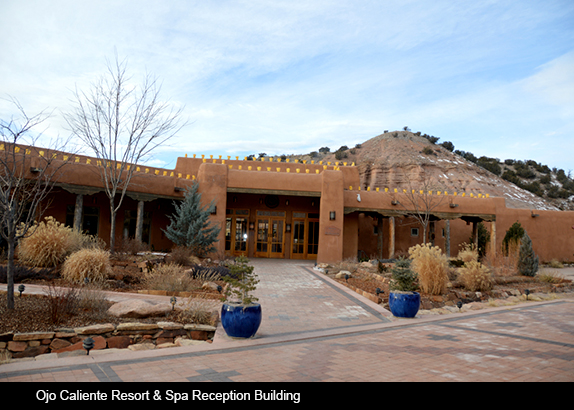
Promotional material, put out by Ojo Caliente Mineral Springs Resort & Spa, is proud to sketch some of the area’s history. We read that the ancient springs have been a gathering place and source of healing for thousands of years, and that use of the waters can be traced back to the earliest human migrations in the region. We learn that ancestors of today’s Tewa tribes built large pueblos and terraced gardens overlooking the springs, and that ruins of Posi and other communities were vibrant centers of urban life inhabited by thousands as recently as the early 15th century.
The 1600s brought the Spanish, of course, with their devastation as well as their chroniclers. Adolph Bandelier and Edgar Hewitt were among those who explored this area’s native sites and their cultures. An early explorer is quoted as having written: “The greatest treasure these strange people possess are hot springs which burst out at the foot of a mountain… So powerful are the chemicals contained in this water that the inhabitants have a belief that they were given to them by their gods.” Such patronizing description are, unfortunately, all too common in recorded history. I find it sad that it is reproduced in Ojo Caliente’s literature; which goes on to say: “the Spanish were challenged in their attempts to colonize the area and cultivate the land throughout the 17th and 18th centuries,” a rather backhanded description of indigenous resistance in the face of colonial invasion.
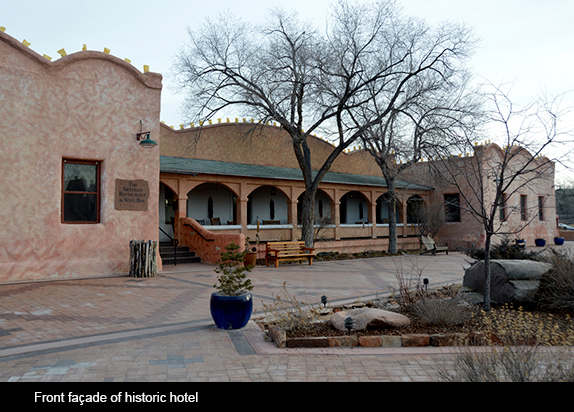
If there is something to be said for the power of these springs, surely it has more to do with the legacy of a people capable of creating gardens that were anything but primitive in their layout, soil and water conservation, a culture that produced Popé and the amazing Pueblo Revolt of 1680, and whose descendants continue to struggle today against obstacles first encountered during the Conquest.
The resort literature claims: “tradition tells us that often-warring tribesmen would set their weapons and differences aside to gather in peace at the springs…” This may well be romantic legend. Yet there is no question that natural springs high in certain mineral content do possess healing, or at the very least soothing, qualities. Throughout time, residents and travelers no doubt took advantage of the waters.
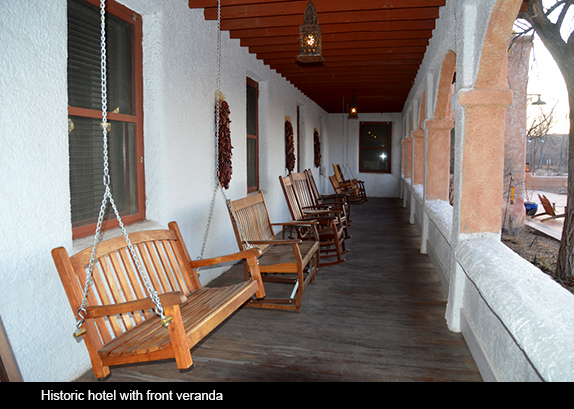
At Ojo more than 100,000 gallons a day steam to the surface and are filtered through a series of pools. In our desiccated state, and in what is one of its worst droughts ever, this is an anomaly worthy of note. The four sulfur-free pools currently feature Iron, Soda and Arsenic; the Lithia pool is not available due to a broken pump, but the resort hopes to get it working again soon. Drinking water from the tap, in both restaurant and room, had that taste (rare these days) of unadulterated and simply delicious thirst-quenching liquid.
I had questions regarding the cleanliness of pools frequented by hundreds of guests, and was comforted in the knowledge that effective recycling systems provide a thorough change of water every 48 hours, with rigorous scrubbing of all surfaces between cycles. The cost of this sort of upkeep probably accounts for the somewhat elevated guest prices, and seems more than fair.
Ojo Caliente’s physical setting alone is worth the visit. In the small surrounding community the original Santa Cruz church, constructed in the late 1700s, features gun portholes in its walls. From these portholes the Spanish defended themselves against attempts by the original inhabitants to regain their homeland. Other buildings, kept up but not lavishly restored, provided a lovely panorama.
Within the resort compound itself, the historic bathhouse (built in 1868), hotel (1916), and adobe round barn (1924) are each worth close examination. Throughout the 19th and 20th centuries, when New Mexico itself attracted sufferers from tuberculosis and other respiratory ills, Ojo Caliente was a magnet for travelers in search of healing. But the history that touched me most was that enshrined in a simple sandstone hill rising right beside one of the open pools. As I soaked in the 102-degree water I gazed at that hill and imagined a much earlier time—so misleadingly called prehistory by many. Faint desert scents seemed to carry ancient stories on the wintery evening air.
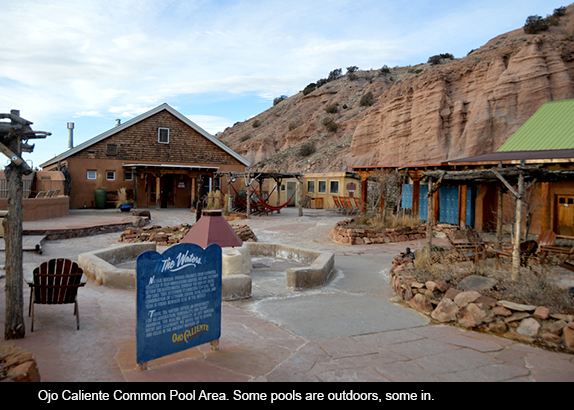
The variety of soaking pools at Ojo offers something for every taste. Aside from the three—perhaps soon to be four—pools with different mineral compositions, there are 11 indoor and outdoor pools with waters ranging from 80 to 109 degrees Fahrenheit. Additionally, there is a sauna and steam room. Iron is considered to be beneficial to the blood and immune system; Soda to the soothing of digestive problems; Arsenic is thought to help arthritis, stomach ulcers, and a variety of skin conditions; while Lithia is good for depression and aids digestion. There is a list of spa therapies to be had with prior reservation and at additional cost, including yoga, herbal baths, restorative foot therapy, hot oil treatments for the hair, mud wraps and other treatments of different sorts.
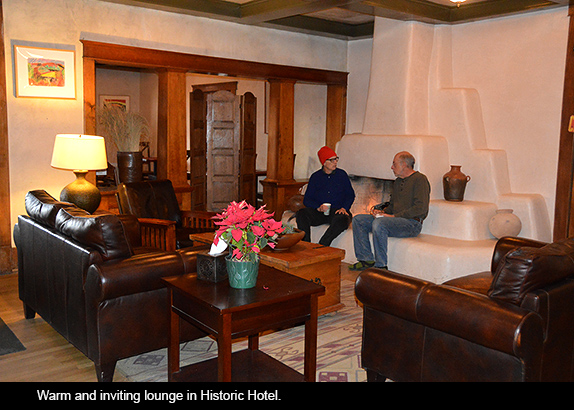
Gift certificate from a generous friend in hand, my partner and I visited Ojo Caliente in early January. Both of us had been there before, my partner in the 1980s when the place was still a rather funky and widely accessible magnet for those in the counterculture. Since then, big changes have taken place. Visitors without a lot of money to spend may still obtain $18 day passes ($28 on weekends or holidays; with an after six p.m. sunset rate of $14 or $24 on weekends or holidays). They may save the price of a room by staying at the campground in summer, or get cheaper accommodations nearby.
Staying at the resort itself is pricier. Guests may reserve rooms that range from the Cliffside Suites with their private outdoor soaking tubs and all the amenities for $350 per night, down to spare rooms in the Historic Hotel at less than half that price. An RV Park and Camping Area are also available for a fee of $20 a day. We opted for a simple room in the Historic Hotel. For $155 on a Monday night we had a modest space with a fairly comfortable queen size bed. The half bath contained only a toilet and a sink. There was no television or Wi-Fi (the latter was available in common areas), but we had not come for those modern touches but rather to get away from the often-overwhelming connectivity of city life.
On the afternoon of our arrival we enjoyed soaking in several of the communal tubs, although walking the equivalent of a city block in winter cold, clothed only in our bathing suits and the cotton robes provided in our room (not terrycloth—those are sold for $75 each in the resort’s shop), made me less than eager to repeat the experience the following morning. Ojo Caliente generously allows guests to enjoy its pools before check-in time on the day of arrival and after check-out time on the day of departure, giving more than your money’s worth for an overnight stay. In a warmer season, I would have relished this option.
A highlight for us was the Artesian Restaurant, also located in the Historic Hotel. We found the food there to be excellent, both at dinner on the night of our arrival and at breakfast before we left the following day. All the dishes we tried were perfectly prepared, served in ample portions and fairly priced. In fact, we realized we could easily have shared a dinner and been more than satisfied.

This time at Ojo Caliente made me think of other hot springs in the state: specifically at Jemez, and in Truth or Consequences. Our favorite spot in T or C is the Blackstone Hot Springs Lodge. We visit it periodically for its friendly getaway, comfortable rooms (many at less than half the price of the cheapest room at Ojo), well-appointed and with private tubs in each. It’s those private in-room hot tubs at Blackstone that call us back again and again. Granted, Truth or Consequences itself is hardly an elegant destination. The southern New Mexican town has struggled for decades. But visiting on any night but Tuesday (when the excellent Bella Lucca Restaurant is closed) makes for a delightful and inexpensive getaway.
Thinking about Ojo and comparing it with Blackstone Hot Springs also brought to mind a phenomenon that exists throughout our state, that of those destinations longing to become “little Santa Fe’s” and those content to remain what they are. There are numerous places in the first category. Ojo Caliente sort of straddles the definition: its Resort & Spa seems to be reaching for the stars while the tiny community in which it is situated probably looks much as it has for years.
In the second category there are a hundred spots, many of them hidden to all but those who travel the state in search of them. The historic downtown center of Truth or Consequences is one. Picturesque Mesilla, outside Las Cruces, Cloudcroft outside Alamogordo, Taos (if you ignore a few upscale hotels), and Pinos Altos outside Silver City are others. I understand the urge to create profit from atmosphere, especially in a poor state with limited industry. But New Mexico’s enchantment resides in its literally dozens, if not hundreds, of unique places with magical histories largely untouched by “progress.” Many of these remain to be discovered, if not by civilization in general then at least by individual travelers. In time, some of these will inevitably succumb to dreams of unsustainable profit. But a state as large and sparsely populated as ours, with as rich a history and variety of cultures, will always reveal some little-visited corner or unsuspected treasure.
Meanwhile, Ojo Caliente is a lovely destination, and definitely restorative as a parenthesis in our much too fast-paced lives.





Responses to “Friday Voyage: Ojo Caliente”